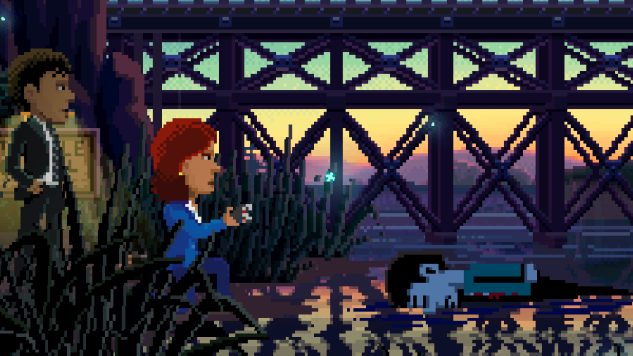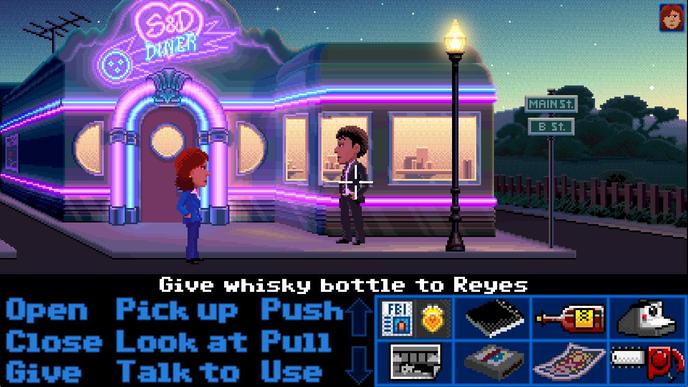
Well, here we are: Thimbleweed Park drops on March 30th, and from the extensive marketing push leading up to the big day, it appears designed to tickle the nostalgia sensors of pixel-starved adventure fiends the world over. Every screenshot has showcased the methodical, loving attention that Ron Gilbert and his team of retro-programmer flunkies have showered on the game to get that authentic flavor just salty enough, and unless I’m way off, those of us who are paying attention to this sort of thing are in for a pretty tasty treat. Come to think of it, though, that’s a question burning a hole in my pocket right now: who, exactly, is paying attention?
I am, for starters. My parents saw fit to raise youthful me on a healthy diet of LucasArts adventure games, and it was with gloomy visage indeed that I watched the components of that diet slowly dwindle into extinction as polygons and three-dimensional landscapes and guns and Turok: Dinosaur Hunter took their place. It’s probably fair to say—albeit thoroughly untestable—that Guybrush Threepwood and his borderline-nonsensical misadventures are responsible for the stupid sense of humor with which I find myself happily saddled today. I know I’ve never looked at a rubber chicken without thinking of Monkey Island, for whatever that’s worth. At least a few pieces of eight, probably.
Doubtless, there are plenty more like me out there. Those who finished up Full Throttle all jazzed up for the sequel, frowned when they heard it was going to submit to market pressure and go 3D, and then bowed their heads in sorrow as it died a premature death at the hands of the fickle, senseless early-2000s game industry. It’s only recently that everyone has pulled their heads out of their asses long enough to realize not every game needs to be an open-world bonanza of collectibles and grim, ambiguous dialogue choices—those games that were so unfairly abandoned years ago deserve a second chance to flourish. I call that an unqualified, net positive for the universe, although I do hope that, in this brave new world of infinite choice where any game on any budget can and will be made available for your grubby paws to download, Thimbleweed Park finds a way to levitate over the morass and get itself good and noticed.
For now, though, let’s set aside the pesky what-ifs and unknowables. Thimbleweed Park is coming out whether or not anybody plays it, so we might as well talk about the particulars of exactly why it’s going to be so awesome. In other words, let’s generate a little buzz, even if that buzz only reverberates in a few select ears.
Let’s start with the art style. Because hot damn—it’s like Maniac Mansion ate a tab of LSD and was finally able expand its mind far enough to experience the full breadth of the color spectrum. It’s pixel art, no doubt, but it’s way more advanced pixel art than anyone seemed capable of cobbling together in the early ‘90s. And that’s the best kind of modern-day, nostalgia-laced game reimagining you can get for your money, if you ask me—a clear respect for and appreciation of the original design, tastefully updated to suit modern sensibilities and steering clear of the uncanny valley that, say, Final Fantasy VI explored in its iPhone evolution. Really, it’s not far afield of the detailed art design that LucasArts began developing for Monkey Island and perfected with Indiana Jones and the Fate of Atlantis—just a little more pixel-dense, and better lit as a result. From the relatively outrageous roster of characters featured at the bottom of the game’s landing page—there’s a guy in a pizza costume, a ghost with electric-looking hair, and an extremely morose clown holding a balloon, among others—it looks like Ron Gilbert has taken pains to preserve the signature humor of the genre as well.
And speaking of characters, what is this game about? That’s one of the bigger mysteries leading up to release date, although promo materials have at least made clear that the game is, in fact, uh, a mystery. A murder mystery, to be specific, and one that involves a “burnt-out pillow factory” and a “body pixelating under the bridge.” It’s as of yet unclear how it’ll all come together, but between that description and the series of dusky, abandoned-town screenshots that have been released, I’m anticipating something noir, something maybe even Twin Peaks-esque if we’re lucky, and something inward-looking and self-aware enough to describe a corpse as “pixelating.” That seems like a potent combination of ingredients to me.
So, what about the interface? That list of verbs looks awfully familiar…wait, is that the SCUMM system? The one that LucasArts ditched back in the late ‘90s with the release of Grim Fandango and Escape from Monkey Island? Be still, my beating heart. It takes a lot of gall to resurrect that dead horse for another beating—even 2014’s Broken Age used a streamlined click-to-interact mechanism that removed a good bit of any potential guesswork. We may be in for an old-fashioned pixel hunt here, opening, pulling, pushing and using every item we can carry on every part of the environment until something happens. Remember the agony, the brain-numbing tedium of poking each and every brick in Maniac Mansion’s dungeon until you found the one that unlocked the secret exit? Remember how mad you were? I can’t wait to experience it all over again. Remember when, in Monkey Island 2, Guybrush gained access to all of the game’s islands at the same time and your heart sank into your stomach as you realized that, given the size of your inventory and how many unique locations you could visit, you were never going to figure out what to do next? Bring it on, I say! Let’s get lost.
Although it may go without saying (I’m saying it anyway), it’s possible I’m wrong, that my excitement is misplaced. This game could be a dumpster fire full of broken pixels and discarded dreams. I doubt it, though, since this sort of nostalgic exercise, when executed correctly and with the right intentions, has proven to be remarkably immune to any sort of lasting criticism. There’s a built-in audience—of which I’m a ranking member—ready to respond to negativity: “Oh, you don’t like the game? You just don’t get it. You weren’t there the first time around. You know, back in 1994. 23 years ago, when Kurt Cobains still roamed the Earth.” For whatever reason, retro-inspired adventure games are no rarity in 2017, and a lot of them are genuinely great, but it’s always a thrill to have the guys who kicked the whole thing off decades ago step back into the fray to demonstrate their chops and show off what they can do with a few pixels and a sense of humor.
Excited yet? Just me? That’s okay—I’d better go make sure my pointing-and-clicking finger is in fighting shape anyway.
When he’s not chained to his desk during the workdays, Lewis Beard is a writer, gamer, and musician living in Atlanta, Georgia. You can check out his thoughts on a wide range of random, possibly compelling topics at run4itmarty.com, and you can bask in the filthy goodness of his music on Bandcamp.
